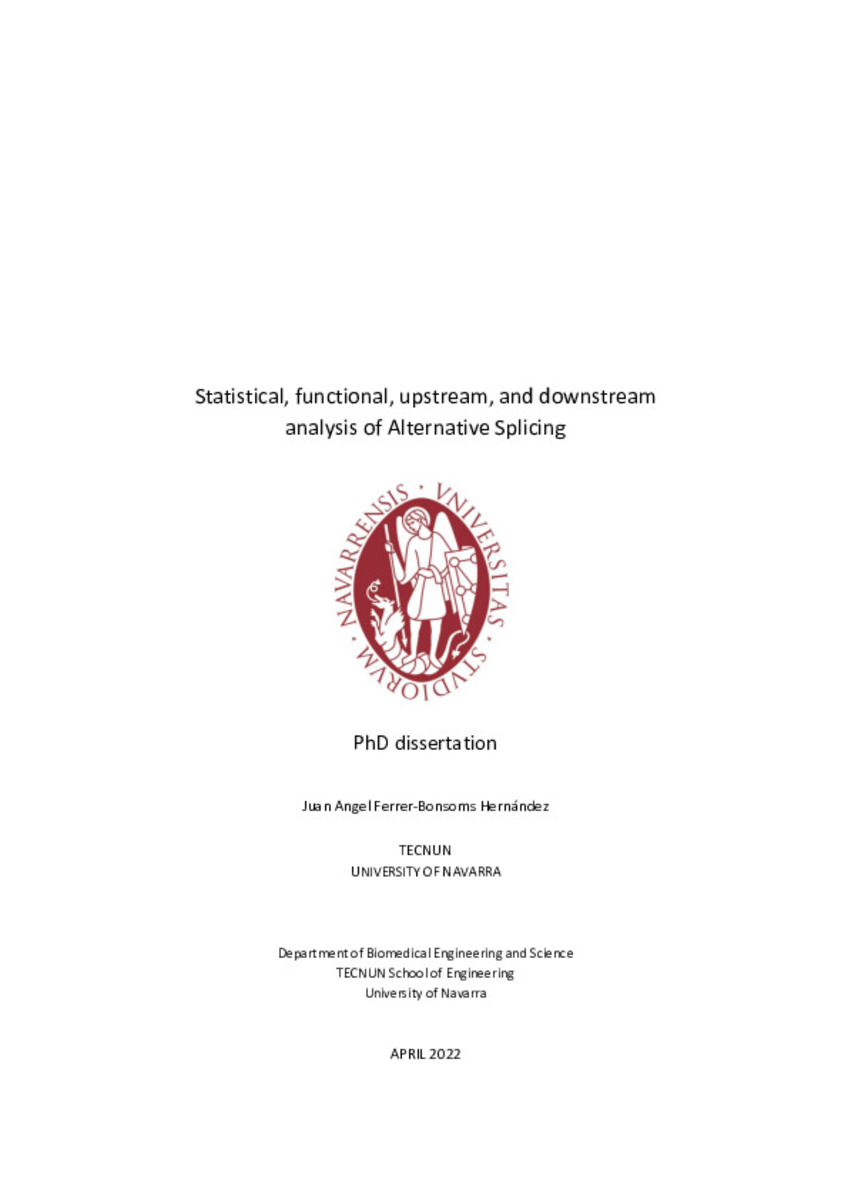Full metadata record
| DC Field | Value | Language |
|---|---|---|
| dc.contributor.advisor | Rubio-Díaz-Cordovés, Á. (Ángel) | - |
| dc.creator | Ferrer-Bonsoms, J.A. (Juan A.) | - |
| dc.date.accessioned | 2022-05-06T12:25:17Z | - |
| dc.date.available | 2022-05-06T12:25:17Z | - |
| dc.date.issued | 2022-04-21 | - |
| dc.date.submitted | 2022-04-08 | - |
| dc.identifier.citation | FERRER-BONSOMS, Juan.A. "Statistical, functional, upstream, and downstream analysis of Alternative Splicing." Rubio, A. (dir.). Tesis doctoral. Universidad de Navarra, Pamplona, 2022 | es_ES |
| dc.identifier.uri | https://hdl.handle.net/10171/63441 | - |
| dc.description.abstract | Alternative splicing (AS) is a post-transcriptional process by which a single gene can lead to different mRNAs and thus to different functional proteins. AS plays a key role in different diseases including cancer. In fact, all hallmarks of cancer have been associated with different mechanisms of abnormal AS. Therefore, AS has been studied as a source of novel biomarkers for survival or even as therapeutic targets. The advantage of RNA-Sequencing (RNA-Seq) technologies has improved the genetic analysis of the human transcriptome. With the recent advances, it is possible to estimate isoform concentrations with good accuracy. Further, several methodologies have been developed to statistically analyze alternative splicing events. However, some aspects of AS remain an active field of research. In this work I will focus on the reconstruction of the transcriptome, the statistical analysis, the functional impact of AS, and the regulation of AS. There are RNA-Seq methods that estimate the structure and concentration of the isoforms of a gene, but the accuracy of these methods is far from perfect. Theoretical conditions to state the conditions whether a gene can be identified do exist in the case of single-end reads. Nevertheless, no theoretical results are still available for paired-end reads. Regarding the functional impact of AS, the precise functions of many of the individual isoforms are still unknown. Multiple algorithms predict gene functions based on ontologies such as Gene Ontology, but most of these approaches do not distinguish the different functions of the gene transcripts. Besides, the biological impact of changes in aberrant AS is still an open question. The statistical analysis of AS is a challenging problem due to the different accuracy in the estimate of the abundance of the isoforms and therefore of the differential splicing between conditions under study. A statistical approach that does not take into account these different accuracies for different isoforms will not be optimal. Understanding the mechanism that regulates splicing is also a challenge. There are algorithms that predict which RNA-binding protein (RBP) is driving the splicing. In our group, we developed an algorithm that uses published data on cross-linking immunoprecipitation (CLIP) experiments and makes its predictions relying on an enrichment analysis. Some assumptions of the enrichment analysis do not fit with the data and thus some biases are introduced into the prediction. In this work we faced these challenges. We present a method to select the optimal read-fragment length combination to infer the structure and concentration of the isoforms of a gene for RNA-Seq using paired-end reads. This work also provides a framework to state whether the isoforms of a gene can be inferred from paired-end reads or not. We also developed a novel method to predict isoform specific GO functions. Moreover, we described a novel statistical analysis of Alternative Splicing events based on bootstrap. This statistical analysis can be augmented with a protein domain enrichment analysis that aims to explain the functional impact of alternative splicing. Finally, we developed a novel algorithm that performs an enriched analysis based on the Poisson- Binomial distribution that avoids the biases introduced by the Fisher’s exact test and is faster than the state-of-the-art algorithms. All the outcomes of these studies are available at public repositories. | es_ES |
| dc.language.iso | eng | es_ES |
| dc.publisher | Servicio de Publicaciones. Universidad de Navarra | es_ES |
| dc.rights | info:eu-repo/semantics/openAccess | es_ES |
| dc.subject | Data analysis. | es_ES |
| dc.subject | Biostatistics. | es_ES |
| dc.subject | Alternative Splicing. | es_ES |
| dc.subject | Cancer. | es_ES |
| dc.subject | RNA-Seq. | es_ES |
| dc.title | Statistical, functional, upstream, and downstream analysis of Alternative Splicing. | es_ES |
| dc.type | info:eu-repo/semantics/doctoralThesis | es_ES |
| dc.identifier.doi | 10.15581/10171/63441 | - |
Files in This Item:
Statistics and impact
Items in Dadun are protected by copyright, with all rights reserved, unless otherwise indicated.






